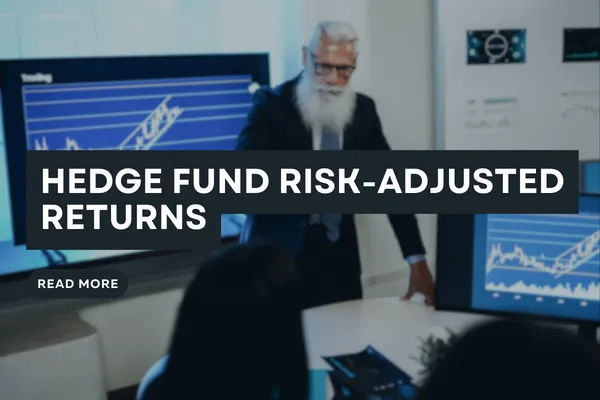Hedge Fund Buyer Blogs

Hedge Fund Risk-Adjusted Returns
Introduction
When you invest your money, you want it to grow as much as possible while making sure it's safe. That's where something called "risk-adjusted returns" comes in. In this article, we'll explain what risk-adjusted returns are, why they're important, and how they relate to hedge funds.
What Are Risk-Adjusted Returns?
Risk-adjusted returns are a way to measure how well an investment performs when you consider the level of risk involved. It's like evaluating a basketball player not just by the number of points they score but also by how many shots they take to score those points. In the world of finance, we want to know if an investment is giving us good returns for the level of risk we're taking.
Why Do They Matter?
Imagine you have two investment options. Option A gives you a 10% return, and Option B also gives you a 10% return. At first glance, they seem equally good. But here's the catch: Option A is less risky, while Option B is quite risky.
Wouldn't you want to know which option is better when you consider the risks involved? That's where risk-adjusted returns come in handy. They help you make smarter investment choices by factoring in risk.
How Are They Calculated?
There are several ways to calculate risk-adjusted returns, but one common method is using a measure called the Sharpe Ratio. Don't worry; we'll keep it simple.
The Sharpe Ratio compares the return of an investment to the amount of risk taken. The higher the Sharpe Ratio, the better the investment has performed relative to its risk. It's like comparing two students: one got an A with minimal effort (high Sharpe Ratio), while the other also got an A but had to work much harder (lower Sharpe Ratio).
Hedge Funds and Risk-Adjusted Returns
Hedge funds are known for their ability to manage risks and potentially deliver high returns. But not all hedge funds are created equal. Some take on more risk than others to chase those high returns.
When you're considering investing in a hedge fund, it's essential to look beyond the headline returns. You want to know if those returns are a result of smart investing or if the fund is taking on excessive risks. That's where risk-adjusted returns can guide you.
The Sortino Ratio
Another useful tool for evaluating hedge funds' risk-adjusted returns is the Sortino Ratio. It's similar to the Sharpe Ratio but focuses only on downside risk. In simple terms, it measures how well an investment performs when things go south.
Let's say you have two hedge funds with the same average return, but Fund A has a higher Sortino Ratio than Fund B. That means Fund A does a better job of protecting your money when the market goes down.
How to Use Risk-Adjusted Returns
So, how can you use risk-adjusted returns to make informed investment decisions, especially when it comes to hedge funds? Here are some steps to consider:
1. Compare Funds
Look at the risk-adjusted returns of different hedge funds. A fund with a higher Sharpe Ratio or Sortino Ratio may be a better choice because it's delivering good returns for the level of risk.
2. Understand Your Risk Tolerance
Before investing, know how much risk you're comfortable with. Risk-adjusted returns can help you find funds that align with your risk tolerance.
3. Diversify Your Portfolio
Diversifying your portfolio is like having a variety of snacks in your lunchbox instead of just one. Imagine you love chocolate chip cookies, and you put ten of them in your lunch. But what if you open your lunchbox, and oh no, your cookies got squished! Now you're left without a tasty treat.
Now, think about having not only cookies but also some chips, an apple, and a sandwich in your lunch. Even if one thing doesn't turn out as expected (like your cookies getting squished), you still have other delicious options to enjoy.
In the world of investing, your "lunchbox" is your portfolio, which is a collection of different investments like stocks, bonds, and maybe even real estate. When you diversify your portfolio, you're spreading your investments across various types of assets. This way, if one investment doesn't do well, it's not a big deal because you have other investments that can help balance things out.
Diversification helps reduce the risk of losing a lot of money if one type of investment doesn't perform well. It's like having a safety net for your financial future. So, just like you wouldn't want to rely on only one type of snack in your lunch, it's a smart idea not to rely on just one investment in your portfolio. Diversify, and you'll have a better chance of reaching your financial goals while keeping your money safe and sound.
4. Monitor Your Investments
Monitoring your investments is like taking care of a garden. Just as you watch your plants to make sure they're healthy and growing, you need to keep an eye on your investments to ensure they're doing well too. But what does it mean to "monitor" your investments?
Monitoring simply means regularly checking how your investments are doing. Think of it as looking at the report card for your money. You want to make sure it's getting good grades (growing) and not failing (losing value).
Here are some things you can do to monitor your investments:
Check Your Statements: Most investments, like stocks and funds, provide statements that show how they're performing. You can usually access these online or receive them in the mail.
Track the Numbers: Pay attention to the numbers on your statements. Are they going up or down? If they're going up, that's great! If they're going down, it's essential to understand why.
Research and Learn: Take some time to learn about the investments you've made. Understand what factors can affect their value, like the economy or changes in the company (for stocks).
Set Goals: Think about what you want to achieve with your investments. Are you saving for a big purchase, like a car or a house? Or are you planning for your future retirement? Your goals will help guide your investment choices.
Diversify: Don't put all your money in one investment. Spread it out into different types of investments. This can help lower your risk.
Ask for Advice: If you're unsure about your investments or need guidance, consider talking to a financial advisor. They can provide expert advice tailored to your goals.
Stay Informed: Keep up with financial news and trends. Sometimes, what's happening in the world can impact your investments.
Remember, just like your garden needs care and attention to thrive, your investments need monitoring to grow and meet your financial goals. So, make it a habit to check on your investments regularly and make adjustments as needed to keep your money on the right track.
In conclusion, risk-adjusted returns are a valuable tool for investors, especially when evaluating hedge funds. They help you assess whether an investment is worth the risk and make informed choices to grow your money wisely. So, next time you consider investing, remember to look beyond the surface and consider the risks involved. Your financial future will thank you for it!
Get In touch

Hedge Fund Buyer
(803) 310-7106
100 Old Cherokee Rd

